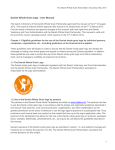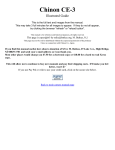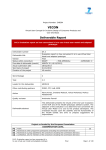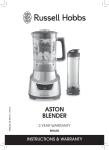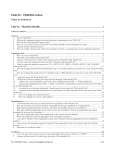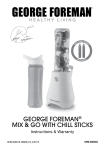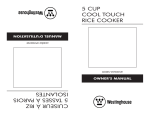Download Danish Whole Grain Logo - User Manual
Transcript
The Danish Whole Grain Partnership’s Secretariat, May 2013 Danish Whole Grain Logo - User Manual The board of directors of the Danish Whole Grain Partnership approved this manual on the 3rd of August 2012. The board of directors further approved this manual in its revised form on the 7th of March 2013. Only the board of directors can approve changes to this manual, with veto rights from the Danish Veterinary and Food Administration and the Danish Whole Grain Partnership. This manual is valid until the end of the current campaign period, which expires on the 31st of March 2017. Chapter 1: Eligibility guidelines for the use of the Danish whole grain logo by individual persons, companies, organisations, etc., including guidelines on the financial terms applied. These guidelines were developed in order to ensure that the Danish whole grain logo and hereby the message on eating more whole grains are spread out widely among the Danish population. In addition, these guidelines are used to control the use of the Danish whole grain logo such that its authenticity, merit, and its message’s credibility are preserved at all times. 1.1 The Danish Whole Grain Logo The Danish whole grain logo is trademark registered with the Danish Veterinary and Food Administration and the Danish Whole Grain Partnership. The Danish Whole Grain Partnership’s secretariat is responsible for the logo administration. 1.2 Use of the Danish Whole Grain logo by partners The partners in the Danish Whole Grain Partnership are listed on www.fuldkorn.dk. The partners are free to use the Danish whole grain logo in accordance with the design and application guidelines described in this manual. New partners, such as food producers, organisations, and other stakeholders can be granted permission by the board of directors to use the logo against payment of a participation fee. Food producers must have at least one product on the market that lives up to the logo’s application rules. The payment of the participation fee allows for the use of the Danish whole grain logo on products, packages, flyers, websites, letterheads, advertisements, etc., as long as its use follows the guidelines described in this manual. 1 The Danish Whole Grain Partnership’s Secretariat, May 2013 Generic exposure of the Danish whole grain logo as described in section 1.4, and editorial coverage and mentions do not require the payment of a fee. The Danish Whole Grain Partnership’s secretariat will provide guidance on this subject. 1.3 Partnership Agreement and participation fee All producers, organisations, and other stakeholders that have signed a written agreement and have been approved by the Danish Whole Grain Partnership’s board of directors are welcome to join the partnership agreement, and are allowed to use the Danish whole grain logo throughout the campaign period. The agreement must be signed and sent to the Danish Whole Grain Partnership’s secretariat before the logo is used. The partnership agreement should be sent to the campaign manager. In order to join and ensure full participation in the Danish Whole Grain Partnership a fee of 50.000 DKK/year is to be paid, if the company’s turnover is higher than 15 million DKK/year. For companies with a turnover lower than 15 million DKK/year the fee is 25.000 DKK/year. The participation fee ensures full participation in the Danish Whole Grain Partnership. The participation agreement for the Danish Whole Grain Campaign, the use of the Danish whole grain logo, and the associated fee are signed for, for a period of three years – or otherwise throughout the current campaign period. However, the partners are bounded for a period of one accounting year at a time – according to §1 in the partnership agreement. Each producer, organisation, or other stakeholder that wishes to use the Danish whole grain logo will pay for one participation fee only, regardless of number of products that live up to the logo’s guidelines, or how many stores, workplaces, etc. the producer or organisation provides for. However, independent juridical units in the same organisation or company must sign individual partnership agreements. 1.4 Use of the Danish whole grain logo by others outside of the Danish Whole Grain Partnership Stakeholders that aren’t members of the Danish Whole Grain Partnership are welcome to help promote the Danish whole grain logo as described in this guideline manual and in the logo design manual. The following restrictions apply to stakeholders outside of the Danish Whole Grain Partnership: • The Danish whole grain logo as well as the slogan “Vælg fuldkorn først” (“Choose whole grain first”) are not allowed on the stakeholders’ packages and similar • The Danish whole grain logo as well as the slogan “Vælg fuldkorn først” (“Choose whole grain first”) may not be used in the marketing of specific products – e.g. in adverts or similar • The Danish whole grain logo as well as the slogan “Vælg fuldkorn først” (“Choose whole grain first”) may not be used for direct or indirect marketing of the stakeholder in question. 2 The Danish Whole Grain Partnership’s Secretariat, May 2013 For stakeholders external to the Danish Whole Grain Partnership it applies, that the Danish whole grain logo follows the product. Meaning, if an external stakeholder distributes a product that is produced by a partner in the Danish Whole Grain Partnership, and which carries the Danish whole grain logo, the external stakeholder is allowed to use the logo for marketing the product, even though the external stakeholder is not a member of the Danish Whole Grain Partnership. Please find examples of cases in section 2.4 “Partner and non-partner use of the Danish whole grain logo”. Stakeholders outside of the Danish Whole Grain Partnership can, for instance, use the logo as follows – see also section 2.4: • In educational materials – e.g. for use in schools • As part of generic information – e.g. in a municipal framework, in hospitals, etc. • In media contexts – e.g. in newspaper articles or electronic media • In the retail area (see section 2.4) • In canteens, restaurants and similar (see section 2.4) • In bakeries, in-store bakeries, and similar (see section 2.4) An important condition for the use of the Danish whole grain logo is that the logo is never used in a way that could be interpreted as misleading – according to ordinary misleading-avoidance guidelines. The Danish whole grain logo must only be presented in a context where its appearance is natural. The remaining text, sound, pictures, and illustrations (among other) must underline the message about whole grain and be in accordance to the logo. Furthermore, the guidelines for logo design must be held. 1.5 Control of the use of the Danish whole grain logo The Danish Veterinary Administration’s regions conduct the governmental control for the use of the Danish whole grain logo with particular emphasis on misguidance aspects. This is part of the Danish Veterinary Administration’s customary and regular control with inter alia labelling, and the processing of individual cases that might be reported. The Danish Veterinary Administration’s control includes control of whether the rules for the use of the logo are properly applied, and whether the logo is used in a misleading way. It is the company’s responsibility to document that a logo-carrying product follows the guidelines for its application, when required to do so under inspection. More details on how this control is undertaken can be found on the Danish Veterinary Administration’s website, www.fvst.dk. 1.6 Withdrawal of the right to use the Danish whole grain logo The Danish Whole Grain Partnership’s secretariat maintains an updated partner list on the website www.fuldkorn.dk. Wrongful use of the Danish whole grain logo in accordance to 3 The Danish Whole Grain Partnership’s Secretariat, May 2013 chapter two in this manual by any partner with a signed partnership agreement gives the Danish Whole Grain Partnership’s secretariat the possibility of withdrawing their right to use the logo. Chapter 2: Guidelines for use of the Danish whole grain logo 2.1 Purpose of use of the Danish whole grain logo For the partners engaged in the Danish Whole Grain Partnership the purpose of use of the Danish whole grain logo is to disseminate knowledge of the logo and of the slogan “Choose whole grain first”. Furthermore, general knowledge about whole grain should be increased. The background for the Danish whole grain logo’s existence is the Danish Veterinary Administration’s official recommendation on whole grain intake, as stated in the official 8 national dietary recommendations: Choose whole grain Eat at least 75 grams whole grain per day. You find whole grain in foods made from cereals where the whole grain is included. 75 grams whole grain is e.g. 2 dl rolled oats / oatmeal, and one slice of rye bread. Choose whole grain first – it is easy if you look for the Danish whole grain logo when you buy your groceries. The Danish whole grain logo is your guaranty for a high content of dietary fibre and whole grain in bread, groats, flour, breakfast cereals, rice, and pasta. Choose rye bread or other whole grain bread for your packed lunch. You can choose whole grain rice or whole grain pasta as part of your warm meal a couple of times a week. The overall goal for the Danish Whole Grain Partnership’s work is stated in the partnership’s vision and mission statements: Vision The Danish Whole Grain Partnership promotes public health by contributing to a higher intake of whole grain amongst the Danish population. Mission The Danish Whole Grain Partnership increases the Danish population’s accessibility to whole grain products, and disseminates knowledge of the benefits of whole grain. 4 The Danish Whole Grain Partnership’s Secretariat, May 2013 The dietary recommendation on whole grain is just one among several dietary recommendations, and as such it is important that communication of the whole grain logo is not in conflict with the remaining dietary recommendations. The guidelines in chapters two, three, and four ensure that. Besides, these guidelines guarantee the credibility of the Danish whole grain logo. The Danish whole grain logo’s purpose is to make it easy for consumers to choose products with a high whole grain content (as long as the products overall nutritional profile is also recommendable). Furthermore, the Danish whole grain logo fulfils a function as the visual linking element for a series of different activities within the scope of the Danish Whole Grain Partnership’s work. 2.2 Application terms The context in which the Danish whole grain logo is presented must be in accordance with the logo’s purpose, and it must neither mislead nor confuse the Danish population. The Danish whole grain logo must only be presented in contexts where it is natural. E.g. information and teaching materials whose purpose is to inform the public about healthy foods, grocery shopping, storage, preparation, and choice of products with a high whole grain content. Other text, voice-overs, pictures, and illustrations – e.g. with other products – must still stress the message on whole grain, and must also be in accordance with the logo. The Danish whole grain logo might also be used in campaigns that live up to the overall vision for the Danish Whole Grain Partnership – which is to promote public health by helping the Danish population eat more whole grain. The Danish Whole Grain logo can be used in all types of campaign materials, e.g. videos, radio and TV shows, internet materials, newspapers and magazines, posters, flyers, and other publications. For the use of the Danish Whole Grain logo on labels of pre-packaged goods, and on recipes, please check the specific guidelines under sections 2.3, 2.4, and chapter 3. The use of the Danish whole grain logo in goods and products must not give the impression that a specific product or a particular brand is recommended rather than other whole grain logo-carrying products. 2.3 Demands and product requirements Overall, it is important that products carrying the Danish whole grain logo contribute to the image of a credible logo, which is a guaranty for healthy whole grain products. 5 The Danish Whole Grain Partnership’s Secretariat, May 2013 The designation “whole grain products” covers the following types of products: • Flour, groats, flakes, cracked kernels, and rice • Bread and bread mixes • Crisp bread and crusts • Breakfast cereals and muesli • Pasta and noodles (without fill) • Porridge and instant porridge powders Whole grain content requirements for products with the Danish whole grain logo: • Flour, flakes, groats, cracked kernels, and rice: 100% whole grain calculated as product dry matter (% DM) • Bread: At least 50% whole grain calculated as product dry matter (% DM), and at least 30% whole grain calculated as quantitative ingredient declarations (QUID). Both requirements must be met. • Crisp bread and crusts: At least 60% whole grain calculated as product dry matter (% DM) • Breakfast cereals and muesli: At least 60% whole grain calculated as product dry matter (% DM) • Pasta and noodles (without fill): At least 60% whole grain calculated as product dry matter (% DM) • Porridge and instant porridge powders (for instant powders the requirement applies to the product after preparation): At least 70% whole grain calculated as product dry matter (% DM). Calculation of whole grain content as product dry matter: % whole grain calculated as product dry matter (%DM) = amount of dry matter from whole grain ingredients / product’s total amount of dry matter Whole grain is defined as the whole kernel of corn / cereals (germ, endosperm, bran); the kernel might be grounded, cracked, or similar, but the constituents for the respective cereals must be included in the same ratio as in the intact kernel. It therefore follows, that it is not allowed to use the Danish whole grain logo on products where the correct ratio between endosperm, bran, and germ is achieved through calculation. The whole grain definition covers the following cereals / corn species: Wheat, spelt or dinkel wheat, rye, oat, barley, maize, rice, millet, durra and other sorghum species. Wild rice and quinoa are not included in the whole grain definition. Other requirements for products with the Danish whole grain logo In order to ensure the use of the Danish whole grain logo only on healthier products, it is also a requirement for these products that they comply with requirements for fat, sugar, dietary fibre, and salt contents that the respective product categories are under in the Danish order for the 6 The Danish Whole Grain Partnership’s Secretariat, May 2013 use of the Keyhole label. The only exception is the requirement regarding fibre content in rice – see also footnote 1 bellow. The following table gives an overview of the requirements for whole grain content, as well as for the content of other nutrients in logo-carrying products. The requirements for fat, sugar, salt, and fibre content are to be understood as the content for these nutrients in the final product, unless otherwise indicated. Product category Flour, flakes, groats, cracked kernels and rice Bread and bread mixes, where only water and yeast need to be added (for bread mixes, the requirements are applied to the final product) Crisp bread and crusts Whole grain 100% whole grain calculated as product dry matter (% DM) At least 50% whole grain calculated as product dry matter (% DM) and at least 30% whole grain calculated as quantitative ingredient declarations (QUID). Both requirements must be met. Other requirements • At least 6 g dietary fibre / 100 g At least 60% whole grain calculated as product dry matter (% DM) • • • • • • • • Breakfast cereals and muesli At least 60% whole grain calculated as product dry matter (% DM) • • • • • Pasta and noodles (without fill) Porridge and instant porridge powders (for instant porridge powders, the requirements are for the final, cooked product) At least 60% whole grain calculated as product dry matter (% DM) At least 70% whole grain calculated as product dry matter (% DM) • • • • • • 1 Fat – max 7 g / 100 g Total sugars – max 5 g / 100 g Sodium – max 0.5 g / 100 g Dietary fibre – at least 5 g / 100 g Fat – max 7 g / 100 g Total sugars – max 5 g / 100 g Sodium – max 0.5 g / 100 g Dietary fibre – at least 6 g / 100 g Fat – max 7 g / 100 g Refined sugars – max 10 g / 100 g Total sugars – max 13 g / 100 g Sodium – max 0.5 g / 100 g Dietary fibre – at least 6 g / 100 g Sodium – max 0.4 g / 100 g Dietary fibre – at least 6 g / 100 g 2 Fat – max 5 g / 100 g Total sugars – max 5 g / 100 g Sodium – max 0.2 g / 100 g Dietary fibre – at least 6 g / 100 g 3 2.3.1 Rules for pre-prepared meals and products Products carrying the Danish whole grain logo must not give the impression of being recommended or approved by the organisations, companies, or authorities behind the logo. A percentage indication of the whole grain content in the final product can be added to the front of a product’s packaging as a supplement to the Danish whole grain logo. The whole grain 1 Whole grain rice will be granted the Danish whole grain logo even if the product is not granted the Keyhole label due to its requirement of at least 6 grams dietary fibre / 100 grams product (the natural dietary fibre content in whole grain rice is only 2-3 grams / 100 grams product). 2 The criteria for pasta and noodles are calculated for product dry matter. 3 The criteria for porridge and instant porridge powders (the final, cooked product) are calculated for product dry matter. 7 The Danish Whole Grain Partnership’s Secretariat, May 2013 percentage indication must refer to the percentage of whole grain content volume included in proportion to the final product (quantitative ingredient declaration - QUID). Meaning, the Danish whole grain logo must not appear together with a whole grain content indication that indicates the whole grain content of the product as a percentage of the flour/grain/cereal content when the product also includes other ingredients. It is e.g. not allowed to write, “50% of the flour is whole grain” on a bread product with the Danish whole grain logo. The following wording must appear on the back (or front) of the product packaging: “The Danish Veterinary Administration recommends the intake of at least 75 grams whole grain a day, as part of a varied diet. This product contains X grams whole grain per 100 grams product”. (Translated from: “Fødevarestyrelsen anbefaler mindst 75 gram fuldkorn om dagen som en del af en varieret kost. Produktet indeholder X gram fuldkorn pr. 100 gram”) This quantitative indication must follow the rules for quantitative ingredients declarations (QUID), i.e. it must be indicated as the detailed whole grain weight calculated in proportion to the weight of the final product, cf. above. E.g. for bread mixes and instant porridge powders the whole grain content in grams / 100 grams product calculated as QUID must be presented as the content in the final, cooked product, in accordance to the cooking guidelines presented in the product’s packaging. E.g.: “The Danish Veterinary Administration recommends the intake of at least 75 grams whole grain a day, as part of a varied diet. This product contains X grams whole grain per 100 grams product, when prepared according to the cooking guidelines in this package.” As a supplement, producers can voluntarily specify the whole grain content per portion. Or the whole grain content calculated as product dry matter (% DM). The Danish whole grain logo does not require use of nutrition labelling, since whole grain is an ingredient and not a nutrient per se. The specification of whole grain ingredients in the ingredient list follows the usual labelling rules. 2.3.2 Rules for non pre-packed products When showing the Danish whole grain logo through non pre-packed products sold over the counter at bakeries, in-store bakeries, and the like, the following must be clear for consumers: • The wording “The Danish Veterinary Administration recommends the intake of at least 75 grams whole grain a day, as part of a varied diet” must be visible for consumers – a poster with this wording can be required with the secretariat. • The amount of whole grain in each product (X grams whole grain per 100 grams product) – sheet with adhesive stickers can be required with the secretariat. 8 The Danish Whole Grain Partnership’s Secretariat, May 2013 • • • Bakers can use shelf labels or signs with the Danish whole grain logo and the name of the specific bread directly on the bread or the breadbasket. Bread must not be labelled with e.g. flags or other labelling directly sat on the bread, when the product’s name is not part of the label. Before using the Danish whole grain logo, both the responsible baker and its staff should have undergone the Danish Whole Grain Partnership’s educational material for bakeries. The material can be required with the secretariat. When showing the Danish whole grain logo through non pre-packed products sold over in canteens, restaurants, and the like, it must be clear for consumers: • The wording “The Danish Veterinary Administration recommends the intake of at least 75 grams whole grain a day, as part of a varied diet” must be visible for consumers – a poster with this wording can be required with the secretariat. • The minimal level of whole grain content in the different product categories (e.g. “Bread with the Danish whole grain logo contains at least 30 % whole grain”) – these details appear in the previously mentioned poster. • Which specific products live up to the Danish whole grain logo’s guidelines – e.g. with the help of table signs next to the specific products on a buffet. It is not allowed to place flags nor similar signs directly on the food. • Before using the Danish whole grain logo, the canteen staff should have undergone the Danish Whole Grain Partnership’s educational material for canteens. The material can be required with the secretariat. The Danish Whole Grain Partnership’s secretariat has developed two posters, as previously mentioned – one for bakeries, etc., and one for canteens and similar. These posters were developed taking the rules for use of the Danish whole grain logo into account. The posters can be required with the secretariat or downloaded from www.fuldkorn.dk. 2.4 Partner and non-partner use of the Danish whole grain logo The rules for use of the Danish whole grain logo in a series of specific contexts by, respectively, partners and non-partners are as follows. 2.4.1 Bakeries, in-store bakeries, and similar Non-partners Bakeries, in-store bakeries and similar The logo follows the product – meaning, products eligible to carry the logo from the producers’ side are also allowed to carry the logo when a non-partner is to sell them forward to consumers; e.g. bake off products and 100 % bread mixes where only yeast and water need to be added. Partners – can use the logo in the same way as non-partners and also as described below May use the logo on own breads, if they can document that the bread lives up to the logo guidelines. 9 The Danish Whole Grain Partnership’s Secretariat, May 2013 For both partners and non-partners it applies, that when the Danish whole grain logo is used in stores the labelling requirements described in section 2.3.2 must be met. 2.4.2 Restaurants and canteens Non-partners • Restaurants and canteens • The logo follows the product – meaning, products eligible to carry the logo from the producers’ side are also allowed to carry the logo when served; e.g. fully baked bread, breakfast products, bread mixes where only yeast and water need to be added, as well as rice, pasta and grains that only need to be cooked (restrain salt use here). Are not allowed to use the logo on own products; e.g. own baked bread. Partners – can use the logo in the same way as non-partners and also as described below • May use the logo on all whole grain products that live up to the logo guidelines; e.g. rice, pasta, bread, breakfast cereals and grains, etc. • May use the logo on their own produced bread, if they can document that the bread lives up to the logo guidelines. For both partners and non-partners it applies, that when the Danish whole grain logo is used in canteens, restaurants, and similar, the labelling requirements described in section 2.3.2 must be met. Flags and similar signs are not allowed directly on the food. Before using the Danish whole grain logo, the canteen staff should have undergone the Danish Whole Grain Partnership’s educational material for canteens, which can be required with the secretariat. 2.4.3 Retailers Non-partners • Retailers • The logo follows the product – meaning, products eligible to carry the logo from the producers’ side are also allowed to carry the logo when a non-partner retailer is to sell them forward. May use the logo on private label products produced by a partner in the Danish Whole Grain Partnership. Partners – can use the logo in the same way as non-partners and also as described below May use the logo on private label products – also when non-partners produce these products. The following describes how retailers can apply the Danish whole grain logo, both in-store in retail shops, and in advertisement materials – e.g. supermarket leaflets. Both partners and nonpartners may use the Danish whole grain logo as described bellow. Non-partners are restrained in their use of the logo as described above and in section 1.4. The following is a suggestion that can be used as general guidance for the setup of signs, shelf labels, posters, and similar, with the Danish whole grain logo in shops. But it is difficult to draw very general rules that cover all possible marketing methods in shops. It is therefore hereby emphasized that all marketing applying the Danish whole grain logo is subject to ordinary rules 10 The Danish Whole Grain Partnership’s Secretariat, May 2013 on avoidance of misleading marketing, and subject to the Danish Veterinary Administration’s control and evaluation of the specific conditions in the individual stores. This implies that certain marketing strategies with the Danish whole grain logo might still be considered as violating the logo appliance guidelines, as well as the rules on misleading marketing, even though these strategies apparently follow the suggestions described here. In relevant sections in the shop The suspension of signs and similar with the Danish whole grain logo can take place in sections in the shop where there are logo-carrying products in the shelves – e.g. sections for bread, flour and breakfast cereals – or by displays with logo-carrying products. The suspension of signs and similar must not be misleading for consumers and must follow the ordinary rules on avoidance of misleading marketing and labelling. In hallways and entranceways The suspension of signs and similar with the Danish whole grain logo in hallways and entranceways in order to draw costumers’ attention to the possibility of looking for logocarrying products is generally permitted. If any text is added under the Danish whole grain logo, we encourage for the use of a text that draws the costumers’ attention to the possibility of finding logo-carrying products. If a text can be interpreted as pointing to all products in a section or eventually in the whole store as carrying the whole grain logo, it will be considered to violate both rules for appliance of the Danish whole grain logo, as well as ordinary rules on avoidance of misleading marketing. Marketing in distributed supermarket leaflets, advertisements, promotion signs, etc. The use of the Danish whole grain logo in marketing leaflets and similar implies the presence of logo-carrying products on the same side of the catalogue/leaflet where the overall whole grain message is conveyed, and it further implies the existence of the same logo-carrying products in the store. It is considered acceptable and within the appliance rules for the Danish whole grain logo to use the logo on promotion signs outside of the shops, e.g. with the wording “Choose whole grain first when shopping”. This presupposes that the store offers a certain amount of logo-carrying products. What is considered a sufficient amount of products must be evaluated specifically in each store. Generically here, as well as in all other uses of the Danish whole grain logo, it is important that the marketing of the logo is not misleading for consumers. 2.4.4 Recipes Non-partners Recipes Not allowed to use the Danish whole grain logo. Partners – can use the logo in the same way as non-partners and also as described below May use the logo on recipes subject to nutrient calculation, if these live up to the logo’s appliance guidelines. 11 The Danish Whole Grain Partnership’s Secretariat, May 2013 The Danish whole grain logo may be used in recipes for whole grain products (in accordance with section 2.3) if the recipe is for bread that lives up to the guidelines for use of the Danish whole grain logo. The Danish whole grain logo may be used in recipes for meals included in the category groups 14-17 in the Keyhole labelling rules, as long as the meal’s content of cereal based components lives up to the nutritional requirements for the use of the Danish whole grain logo. The meals should also live up to the nutritional requirements for similar meals in the joint Nordic Keyhole label requirements (appendix 1). 2.4.5 Private label products Non-partners Private label products The logo follows the product – meaning, non-partners may use the logo on private label product series that are produced by partners in the Danish Whole Grain Partnership Partners – can use the logo in the same way as non-partners and also as described below • May use the logo on own private label products. • May use the logo on private label products produced by non-partners. 2.4.6 Pre-packed ready meals and similar Non-partners Pre-packed ready meals and similar Not allowed to use the Danish whole grain logo. Partners – can use the logo in the same way as non-partners and also as described below May use the logo on pre-packed ready meals that live up to the logo guidelines. The Danish whole grain logo may be used in pre-packed ready meals included in the category groups 14-17 in the Keyhole labelling rules, as long as the meal’s content of cereal based components lives up to the nutritional requirements for the use of the Danish whole grain logo. The meals should also live up to the nutritional requirements for similar meals in the joint Nordic Keyhole label requirements (appendix 1). For the rules on labelling see section 2.3. Chapter 3: Guidelines for the specification of whole grain content in products with the Danish whole grain logo 3.1 Delimitations in regard to the European Commission’s nutrition claims regulation The Danish Whole Grain logo includes an official dietary recommendation and may therefore be used with specific products. Due to the EU’s nutritional and health claims regulation, when the Danish whole grain logo is used in a specific product, this can not be supplemented with text and/or illustrations that directly or indirectly mention or refer to the link between intake of whole grain and disease 12 The Danish Whole Grain Partnership’s Secretariat, May 2013 prevention or reduction, or indicate that whole grain is healthy in neither general nor specific terms. It is important to respect these guidelines and live up to the intentions behind them in order to avoid infringements of the rules on nutrition and health claims regulation. Please contact your local Danish Veterinary Administration’s region for guidance in case of doubt regarding specific texts or claims. Users of the Danish whole grain logo are fully responsible for the correct use of marketing texts in connection with the Danish whole grain logo in products, etc., and for the correct declaration of whole grain content in products, consistent with food legislation and nutrition, and health claims legislation. The following are examples of situations in which it is not allowed to use the Danish whole grain logo: • “Whole grain gives you a healthier heart”. A connection between intake of whole grain and prevention of diseases is made in this kind of wording. This is not allowed in relation to or on the specific products/foods. • “Whole grain in rye bread is the best”. In this wording a product category is emphasized, which is not in accordance to the guidelines for use of the Danish whole grain logo. • Statements such as "[Name of health organisation, e.g. The Danish Diabetes Association] recommends that the Danish population eats whole grain” are allowed in the EU’s nutrition claims regulation, as long as this kind of statement is associated with an authorized health claim. (As per January 2013 there are no such authorized health claims for whole grain.) Within the work of the Danish Whole Grain Partnership the mention of the organisation’s name requires the organisations’ or authorities’ written consent (according to section 2.3). Chapter 4: Design and technical guidelines for use of the Danish whole grain logo 4.1 Requirements The specific design and technical guidelines for the use of the Danish whole grain logo are enclosed in the handed out documents and logo files. When an official agreement on use of the Danish whole grain logo is in place, the Danish Whole Grain Partnership’s secretariat provides a username and a password, such that the required logo files can be downloaded through www.fuldkorn.dk. 4.2 Effective date The Danish whole grain logo manual came into force on January 1st 2009. The effective date for its latest changes is March 3rd 2013. 13 The Danish Whole Grain Partnership’s Secretariat, May 2013 Contact address The Danish Whole Grain secretariat c/o Confederation of Danish Industry H.C. Andersens Boulevard 18 1553 Copenhagen V Tlf.: 30 38 15 46 Email: [email protected] 14 The Danish Whole Grain Partnership’s Secretariat, May 2013 Appendix 1 Requirements for pre-prepared meals and similar that can be granted the Keyhole label – according to product categories 14-17 in the appendix to the Danish executive order for the use of the Keyhole label: 14. Pre-prepared meals which are not included in product categories 15, 16 and 17, and that are intended as main courses/meals, and that include: • 400-750 kcal (1670-3140 kJ) per portion or • At least 25 grams root vegetables, pulses and legumes (except peanuts), and other vegetables and/or fruits and berries (potatoes not included) per 100 grams product. 15. Savoury pies (not dessert pies), pierogis, and pizzas based on cereals that contain: • At least 250 kcal (1050 kJ) per given portion, and • At least 25 grams root vegetables, pulses and legumes (except peanuts), and other vegetables and/or fruits and berries (potatoes not included) per 100 grams product. Furthermore, the cereals must contain at least 15% whole grain calculated as the cereals’ dry matter content. 16. Open sandwiches, sandwiches, wraps, and similar products based on cereals that contain: • At least 250 kcal (1050 kJ) per given portion, and • At least 25 grams root vegetables, pulses and legumes (except peanuts), and other vegetables and/or fruits and berries (potatoes not included) per 100 grams product. Furthermore, the cereals must contain at least 25% whole grain calculated as the cereals’ dry matter content. 17. Soups (final products, and instant soups after preparation according to the producers instructions) that contain: • At least 150 kcal (625 kJ) per portion, and • At least 25 grams root vegetables, pulse and legumes (except peanuts), and other vegetables and/or fruits and berries (potatoes not included) per 100 grams final product. • • • • • • • • • • • • Max 30% of the energy content provided by fat. Max 40% of the energy content provided by fat, if the product contains fish with a fat content over 10%, and a max of 10 grams per portion for fat from other ingredients. Refined sugars – max 3 grams / 100 grams Sodium – max 0.4 grams / 100 grams Max 30% energy content from fat. Refined sugars – max 3 grams / 100 grams Sodium – max 0.5 grams / 100 grams Max 30% energy content from fat. Refined sugars – max 3 grams / 100 grams Sodium – max 0.4 grams / 100 grams Max 30% energy content from fat. Refined sugars – max 3 grams / 100 grams Sodium – max 0.4 grams / 100 grams 15 The Danish Whole Grain Partnership’s Secretariat, May 2013 Appendix 2 Calculating the whole grain content of bread There are several criteria for bread must meet so it can be granted the Danish whole grain logo. There are criteria for the content of sodium, sugar, fat, and fibre – the content of these nutrients can be calculated through common nutritional calculation. But besides that, there is a specific criterion for the whole grain content of bread. The whole grain content of bread must be calculated both as dried matter, and as QUID (quantitative ingredient declarations). In this appendix we provide the calculation formula and examples of calculations for both criteria. REMEMBER when using the whole grain logo • Bread must contain a minimum of 50% whole grain calculated as dried matter, and 30% calculated as QUID. • Bread must meet the criteria for sodium (max 0,5 g/ 100 g), sugar (max 5 g/ 100 g – total sugars), fat (max 7 g/ 100 g), and fibers (min 5 g/ 100 g). • Read more about these criteria in our website www.fuldkorn.dk • Read more about criteria for bread in our training material for artisan bakers www.fuldkorn.dk/for-fagfolk/52-haandvaerksbagere Example (this is a hypothetical recipe, in order to illustrate the calculation process). Recipe: 35 g 5g 20 g 30 g 5g 1g 4g 100 g Whole grain wheat flour Sunflower seeds Wheat flour Water Yeast Salt Oil Dough (all in all) Weight of bread after baking = 90 g (due to water evaporation during baking process). 16 The Danish Whole Grain Partnership’s Secretariat, May 2013 Formula for QUID calculation Whole grain ingredient1 + Whole grain ingredient2 etc. x 100 = XQUID % whole grain Weight of bread after baking In other words, QUID is the relation between the weight of all whole grain ingredients and the weight of the final baked bread expressed as a percentage. The criterion for use of the Danish whole grain logo is a minimum content of 30% QUID. As in the above example: 35 g (whole grain wheat flour) 90 g (weight of bread after baking) x 100 = 39 % whole grain Formula for dried matter calculation The content of whole grain calculated as the product’s dried matter is the weight of the dried matter provided by all whole grain ingredients expressed as a percentage of the total weight of dried matter in the final product. The quantity of dried matter is achieved through average values based on either an analysis or a calculation from known or factual average values for the ingredients in the product. The calculation can also be made on the basis of commonly determined and accepted data for the ingredients. In this example we use commonly accepted data from table values. Flour and cereals are the main ingredients in bread. In order to calculate the whole grain content of bread based on its dried matter, a standard value of 15% for flour’s and cereals’ water content can be applied (as long as the water content does not exceed 15%). In other words, these ingredients have a dried matter value of 85%. The bread’s remaining ingredients have other dried matter values. Seeds, for instance, have lower water content. And vegetables have higher water content. 17 The Danish Whole Grain Partnership’s Secretariat, May 2013 In case of doubt whether an ingredient can be considered as flour or cereal, check out the dried matter values in the standard table at www.foodcomp.dk or ask the ingredients’ producer. In the standard value tables at www.foodcomp.dk the water content is given, and the ingredients dried matter is therefore = 100 – the given water content value presented in the table. When a recipe includes seeds like sunflower seeds, pumpkin seeds or linseeds, remember that these ingredients have other dried matter values. For example, www.foodcomp.dk states a water content value of 3.7 for sunflower seeds, so these seeds have a dried matter content of 100-3.7 = 96.3. It is also important to remember that basal ingredients like salt, yeast, and fat also contribute for the calculation of dried matter content, and their values must be taken into account. Formula for whole grain content calculated as dried matter: Whole grain ingredients x 0,85 x 100 = Xdried matter % whole grain (Whole grain ingredients + other flour and cereal ingredients) x 0,85 + all other ingredients times their dried matter values The criterion for the Danish whole grain logo is a minimum of 50% calculated as dried matter. As the above hypothetical example: (35 g whole grain wheat flour) x 0,85 x 100 = Xdried matter % whole grain (35 g whole grain wheat flour + 20 g wheat flour) x 0,85 + (5 g sunflower seeds x dried matter for sunflower seeds) + (5 g yeast x dried matter for yeast) + (1 g salt x dried matter for salt) + (4 g oil x dried matter for oil) If the bread had for instance potatoes, the formula would be: (35 g whole grain wheat flour) x 0,85 x 100 = Xdried matter % whole grain (35 g whole grain wheat flour + 20 g wheat flour) x 0,85 + (5 g sunflower seeds x dried matter for sunflower seeds) + (5 g yeast x dried matter for yeast) + (1 g salt x dried matter for salt) + (4 g oil x dried matter for oil) + (10 g potatoes x dried matter for potatoes) 18


















